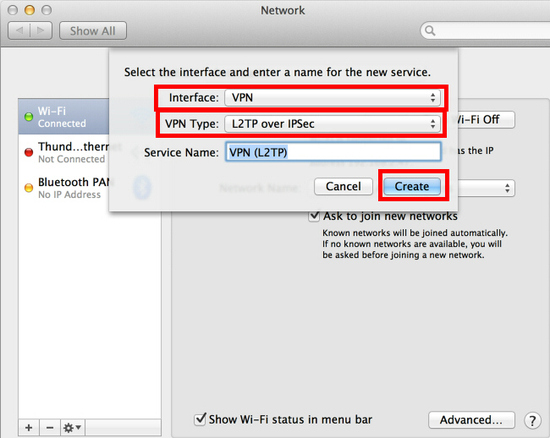Mac Ipsec Vpn Client
The client VPN uses IPsec protocol so UDP ports 500 and 4500 are used and should NOT involve other ports. You can also take a packet capture on The MX's Internet interface during the failure so you can see what is going on with the UDP traffic. The WatchGuard IPSec VPN client installation file (Windows or macOS). The WatchGuard IPSec IPSec VPN client v12.00 and higher has different installers for Windows 32-bit and 64-bit platforms. An end-user profile with a file extension of.wgx or.ini Passphrase; A cacert.pem and a. Use the macOS or iOS Native IPSec VPN Client Apple iOS devices (iPhone, iPad, and iPod Touch) and macOS 10.6 and higher devices include a native Cisco IPSec VPN client. You can use this client to make an IPSec VPN connection to a Firebox.
On the MAC built in VPN (L2TP) configuration in advanced options, you see a check box for 'Send all traffic over VPN connection', but that option is not available in the MAC built in VPN (Cisco IPSec), would this check box be similar to the Cisco client, 'allow local lan access', that particular feature allows for split tunneling in the Cisco. On your Mac, choose Apple menu System Preferences, then click Network. Open Network preferences for me. Select your VPN service in the list at the left. If there’s a Configuration pop-up menu, click it, then choose a configuration. There may be only one configuration available.
The good news first: If you’re currently using the FortiClient to establish a Dialup IPsec VPN (Aggressive, PSK based), the same configuration should also work with the native macOS client.
Because the native macOS client doesn’t offer advanced parameters, the configuration is straight forward:
- Add a new network connection of the type «Cisco IPsec»
- Configure the server address and username
- Enter the Preshared Key (PSK) and optionally the Peer ID in the authentication options
Limitations
- When using two factor authentication (e.g. FortiToken), Challenge-Response isn’t supported. You have to concatenate the code directly after the password (without any separator character).
- For certificate based authentication (PKI), the tunnel must operate in main mode
- If using PKI, the FortiGate must present a valid certificate (macOS does check the FQDN and trust state)
Troubleshooting
The following steps were performed using macOS 10.15.7 and FortiOS 6.4.4.
In case you’re out of luck, the following information will help you to adjust the parameters of the IPsec Tunnel on the FortiGate. The same procedure can be used to identify the parameters of any IPsec client.
A Wireshark capture (udp.port 500) of the initial connection reveals the phase 1 proposals of the IPsec client.
As the Phase 2 is encrypted by the Phase 1, we’ll have to decrypt this data in Wireshark (you could also grab them from the debug output, but it’s less fun). So let’s crank up the debugger on the FortiGate to grab the Cookie and Encryption key:
Now we head to the Wireshark preferences and put this information into Protocols > ISAKMP > IKEv1 Decryption Table.
Wireshark will now reprocess the captured data an reveal the previously encrypted data.
Sample Configuration
Objective
This article shows you how to download and install the Cisco AnyConnect Secure Mobility Client version 4.8 on a Mac Computer. This article is applicable only to Cisco Business products that includes the RV34x series routers and not Enterprise products.
Introduction
AnyConnect Secure Mobility Client is a modular endpoint software product. It not only provides Virtual Private Network (VPN) access through Secure Sockets Layer (SSL) and Internet Protocol Security (IPsec) Internet Key Exchange version2 (IKEv2) but also offers enhanced security through various built-in modules. Why use a VPN? A VPN connection allows users to access, send, and receive data to and from a private network by means of going through a public or shared network such as the Internet but still ensuring a secure connection to an underlying network infrastructure to protect the private network and its resources.
If you are using a Windows computer, click here to view an article on how to install AnyConnect on Windows.
Applicable Devices | Software Version
- RV340 - 1.0.03.17 (Download latest)
- RV340W - 1.0.03.17 (Download latest)
- RV345 - 1.0.03.17 (Download latest)
- RV345P - 1.0.03.17 (Download latest)
AnyConnect and Mac Software Version
- AnyConnect (This document uses AnyConnect version 4.8 | Link to download)
- Mac OS Catalina (10.15) is compatible with AnyConnect 4.8 and later
- Mac OS Mojave (10.14) is compatible with AnyConnect 4.9.05042 and below
Note: You will encounter issues if you attempt to use Mac OS Catalina with earlier versions of AnyConnect (AnyConnect 4.8 Release Notes | Details from Apple )
For more details about the supported operating systems (Windows, Linux, Mac) of the Cisco AnyConnect Secure Mobility Client, refer to the article on Cisco AnyConnect Secure Mobility Client Supported Operating Systems and Requirements. You can also check the Release Notes of the relevant versions for the most updated information.
Install AnyConnect Secure Mobility Client
AnyConnect client licenses allow the use of the AnyConnect desktop clients as well as any of the AnyConnect mobile clients that are available.
Licensing Structure - Firmware versions 1.0.3.15 and later
As of March 2019, using RV340 series routers version 1.0.3.15 and later no longer require server licenses. Now you will need only a client license to download and use the Cisco AnyConnect Secure Mobility Client. A client license enables the VPN functionality and are sold in packs of 25 from partners like CDW or through your company's device procurement.
We recommend the following user license for use with the RV340 Series:
L-AC-PLS-LIC= Qty=25 Duration=12
Licensing Structure - Firmware versions 1.0.2.16 or lower
If you have not yet updated your firmware, please do so now. Do not delay. Click here to visit the downloads page for the RV34X series.
For further information and community discussion on AnyConnect licensing updates, click here.
For AnyConnect Licensing FAQs, click here.
Step 1
Download AnyConnect here.
Install the AnyConnect Pre-deployment Package for the MAC operating systems.
Step 2
Double-click the installer.
Step 3
Click Continue.
Step 4
Go over the Supplemental End User License Agreement and then click Continue.
Mac Cisco Ipsec Vpn Client
Step 5
Click Agree.
Step 6
Choose the components to be installed by checking or unchecking the corresponding check boxes. All components are installed by default.
The items you select in this screen will appear as options in AnyConnect. If deploying AnyConnect for end-users, you may want to consider deselecting options.
Step 7
Click Continue.
Step 8
Click Install.
Step 9
(Optional) Enter your password in the Password field.
Step 10
Click Install Software.
Step 11
Vpn For Mac


Click Close.
You have now successfully installed the AnyConnect Secure Mobility Client Software on your Mac computer.
Additional Resources
AnyConnect App
To try out AnyConnect on mobile devices, the App can be downloaded from Google Play store or Apple store.
View a video related to this article...
Click here to view other Tech Talks from Cisco